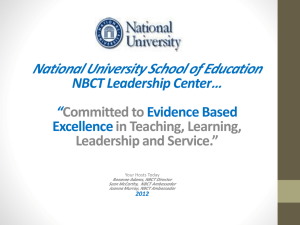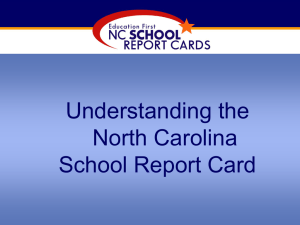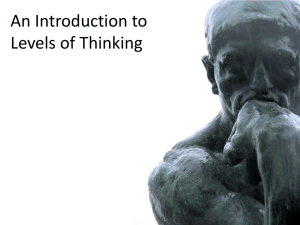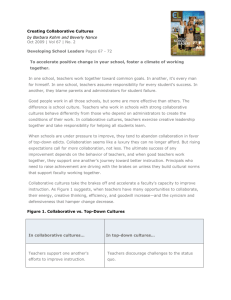principal-201O-EDA
advertisement
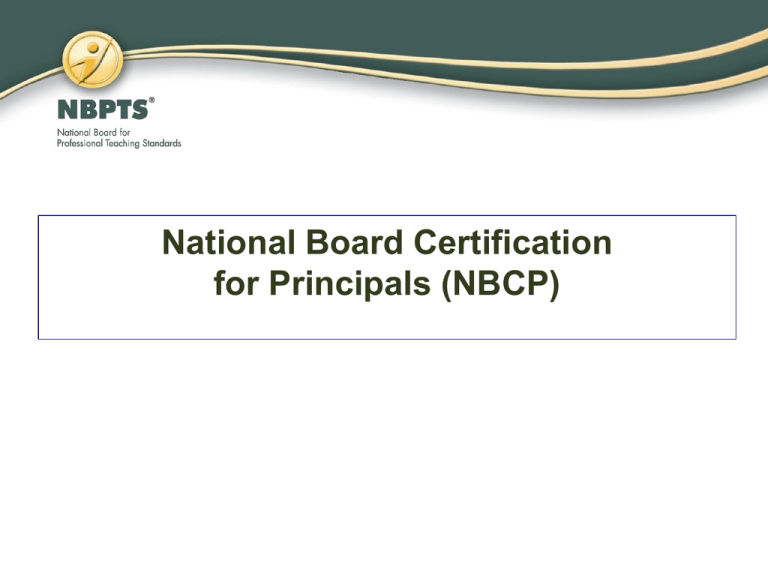
National Board Certification for Principals (NBCP) Integrated System Core Propositions Educational Leaders Standards Principal Leaders Assessment Principal Leaders Scoring Rubric Score All Core Proposition Working Groups 1 1 1 1 1 1 1 1 2 2 1 2 1 1 1 1 NBCT 1 1 1 Teacher Leader 2 1 1 1 2 1 1 1 1 1 1 Higher Education 1 1 Principal/Asst. Principal School Administration/District Level Organizational Leader 1 2 1 2 1 1 1 3 1 1 Core Propositions Overall 5.00 4.50 Average Rating 4.00 3.50 3.00 Teacher (N = 1844) Teacher Leader (N = 358) 2.50 Principal (N = 2578) All Respondents (N = 4851) 2.00 1.50 1.00 Provide a substantive vision of and foundation for what educational leaders should know and be able to do Provide substantive vision of and will remain the foundation for accomplished educational leaders for the next decade Rating Category Teachers: Only Licensed Teachers Teacher Leaders: Licensed Teacher Leaders (All are also Licensed Teachers) Principals: Licensed Principals (2520 are also Licensed Teachers or Teacher Leaders) All Respondents: All Teachers, Teacher Leaders, Principals and Other Principal Eligibility Resolved, that the Board of Directors adopts the following eligibility requirements for principal leader certification: • Hold a bachelor’s degree, • Have completed three full years as a principal leader, • Possess a valid required states license for that period of time, or, if a principal where a license is not required, have been a principal in schools recognized and approved to operate by the state and federal government. • Further, the committee recommends that the same eligibility requirements apply to assistant principals, adding the word assistant prior to principal. Pamela Salazar Associate Professor of Practice and Educational Leadership Las Vegas, NV James L. Pughsley Former Director, Darden-Curry Partnership for Leaders in Education Charlotte, NC Where We Are Now Technical Advisory Group (TAG) • • • • • • Lloyd Bond Robert Lee Linn Richard Luecht Gina Schuyler Ikemoto Michael Rodriguez Gary Skaggs Assessment Overview Overarching Committee Guidelines to NBPTS • • • • Active, relevant site-based evidence Process and systems based evidence Content measured through application Consistent accomplished performance Naming Conventions Accomplished Principal Working Portfolio Entries: Components with supporting evidence Accomplished Principal Profile School Effectiveness Contextual Profile and Strategic School Plan Student Efficacy and Growth Teacher Efficacy and Effectiveness Parents and Community Engagement Principal Leadership, Personal Reflection and Growth Continuous Improvement and Accountability Types of Evidence • • • • • • • School Profile School Plan Case Studies Interview Video or Audio Survey(s) Written documentation Standard Representation by Entry Entry One Standard 1. Leadership For Results 2. Vision and Mission 3. Teaching and Learning 4. Knowledge of Students and Adults 5. Culture 6. Strategic Management 7. Advocacy 8. Ethics 9. Reflection and Growth Strategic Plan Entry Two Entry Three Entry Entry Entry Four Five Six Parent and Student Teacher Principal Community Continued Efficacy Efficacy Leadership, Engagement Improvement and and Growth and and Accountability Growth Growth Reflection Empowerment Behavior Dimension Description Gathering Data Gathering a rich variety of relevant information from a wide range of credible sources providing diverse perspectives about the internal and external environments. Analyzing Information and Identifying Solutions Analyzes, interprets, and links information leading to evidence based solutions. Thinking Flexibly Continuously evaluates options from many different perspectives and selects the course of action most likely to lead to the required outcome. Valuing others and their perspectives Create and nurture a safe and open culture where each individual's thoughts, needs and perspectives are heard and understood so that each member of the learning community feels included and valued. Collaborating Create and sustain a cohesive culture of teamwork where individuals from across the learning community work together, combining thoughts, ideas and resources to achieve common objectives. Developing Human Capital Establishing high expectations about the performance of all adults and students in the learning community and providing challenging development experiences required to meet those expectations. Cultivating Ownership and Support Continuously influencing stakeholders by involving and engaging them in the development, articulation and delivery of a shared vision, mission and goals of the learning community. Building Confidence Building a school culture where there is a strong and decisive leadership supporting the self efficacy of each stakeholder, and the stakeholders confidence in the organization's collective ability to realize the vision and mission. Communicating Establishes sound community processes where clear, consistent and targeted messages in the appropriate media are effectively presented to the relevant audience. Planning, Implementing, and Empowering Developing and implementing evidence based strategic plans designed to move the organization toward achieving the vision and mission, through empowering the key stakeholders. Goal Setting, Monitoring, and Adapting Collaboratively setting challenging, realistic targets, continuously monitoring the progress and adapting plans to successfully achieve the vision and mission. Stakeholder Centered Ensuring that every strategy, plan and action is aligned and focused on actualizing the vision that all students and adults will learn and perform at high levels. 16 Leadership Survey Table 2: Dimensions Measured in the Engagement Survey Engagement Dimensions Measured Group Students Level of Academic Challenge Student–Staff Interaction Active and Collaborative Learning Enhancing Educational Experiences Student Commitment Levels The School Environment Parents Level of Academic Challenge Student–Staff Interaction Active and Collaborative Learning Enhancing Educational Experiences Student Commitment Levels The School Environment Parent–Learning Community Interaction Level of Academic Challenge Active and Collaborative Learning Enhancing Educational Experiences Teachers and Nonteaching Staff The School Environment Work and Community Engagement Work Withdrawal Student–Staff Interaction Active and Collaborative Teaching Student Commitment Levels Parent–Learning Community Interaction Organizational Citizenship Turnover Intentions Broader Engagement Statement Level of Academic Challenge Active and Collaborative Learning Enhancing Educational Experiences The School Environment Work and Community Engagement Work Withdrawal Student–Staff Interaction Active and Collaborative Teaching Student Commitment Levels Parent–Learning Community Interaction Organizational Citizenship Turnover Intentions Broader Learning Community Principal Engagement Survey Levels of Proficiency Level Description Type of Behavior 5 Legacy Exemplifies visionary leadership actions and initiates change at the cultural level resulting in systems that achieve desired and sustainable results beyond the presence of the principal. 4 Advanced Shows visionary leadership actions and initiates change at the cultural level resulting in systems that achieve desired and sustainable results. 3 Core Takes leadership actions and manages change at the organizational level resulting in systems that achieve desired results. 2 Undeveloped Takes limited leadership actions and reacts to change at the situational level resulting in inconsistent results. 1 Counterproductive Takes actions that detract from the performance of self and others resulting in undesired results. Pilot Test Design • Southern Regional Education Board (SREB) Purpose of Field Test • Validate certification process • Ensure process is meaningful and fair • Ensure process elicits evidence of Accomplished Principal Standards • Validate scoring procedures • Establish cut-score Field Test Participant Selection Process Principal Characteristics • Gender • Race/Ethnicity School Characteristics • School Level • School Context • School Size by Enrollment • School Poverty by Percent Students Qualifying for Free or Reduced Lunch Principal Certification Field Test States Alabama Arkansas California Colorado Delaware Florida Georgia Illinois Iowa Louisiana Maryland Maine Nevada Ohio New Mexico Texas New York Washington North Carolina Cahn Fellows Program for Distinguished New York City Principals Principal Leadership Institute (PLI), University of California, Berkeley Field Test Participant Requirement • 400 participants • 600 Participants 2,000 Applicants Due November 30 – Submitted January Entry One: Contextual Information and Strategic Plan • Written and visual contextual information (not scored) • Learning Community Engagement and Leadership Survey (not scored) • Analytical Report • Vision and Mission Statement • Strategic Plan On-Going Structured Support • • • • • Webinars by developmental groups Focus groups E-mails Announcements All Webinar videos on account site Changes in Practice • Accomplished Principal Standards provide a framework • Core Propositions for Educational Leaders demonstrate the complexity of the role • Reflection – Evaluate own leadership as well as school, teacher and student performance • Rather than drive fire truck to put out fires, purposeful structure to days • Start focus on journey rather than destinations • Acting on feedback from surveys Certify the Best and Grow the Rest NBCP Strategic Initiatives • Tiered Licensure • Higher Education Credit • Reciprocity The Benefits • Standardization Common definition Efficiency of Scale • Serves the Continuum Preparation Induction Certification Beyond
